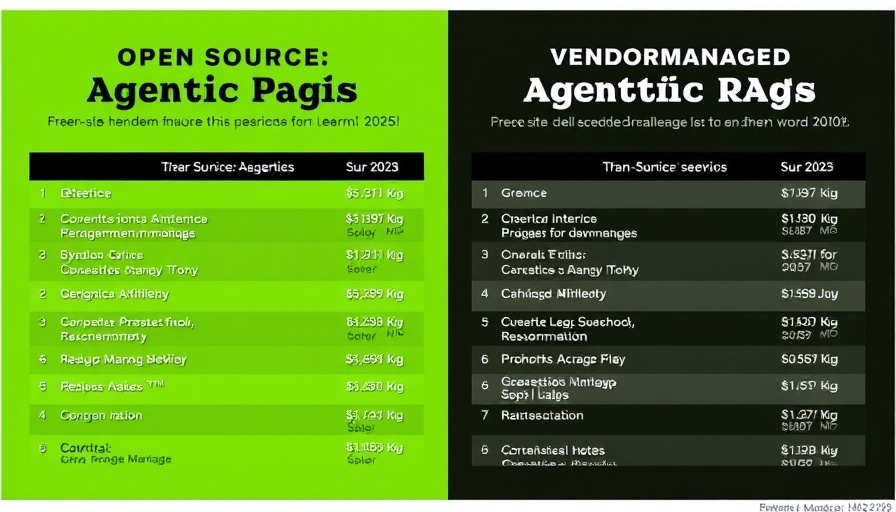
Understanding Agentic RAG: A Hybrid Innovation in AI
In today’s fast-paced business environment, small and medium-sized enterprises (SMEs) are increasingly looking for tools that allow for better efficiency and responsive decision-making. One such innovation is Agentic RAG (Retrieval-Augmented Generation), an advancement over traditional RAG systems that integrates the principles of autonomous decision-making and adaptive reasoning.
While standard RAG relies on large language models to retrieve information and generate responses, Agentic RAG introduces AI agents capable of independent orchestration of the entire process — from generating queries to validating responses. These agents not only pull data but actively choose the best sources, execute APIs/tools, and refine their search iterations until optimal answers are achieved. This flexibility is crucial for enterprises that require accuracy and speed in their operations.
The Competition: Why Go Beyond Vanilla RAG?
So what sets Agentic RAG apart from its vanilla predecessor? It addresses traditional RAG's challenges, such as misunderstandings stemming from vague questions and noise in data collated.
With behavior modifications like:
- Planning and Query Decomposition: The agent first strategizes how to approach the question, determining how to break it down into manageable parts before kicking off the search process.
- Conditional Retrieval: The system evaluates in real-time whether additional data retrieval is warranted, adjusting its approach based on contextual needs.
- Self-reflection Loops: In cases where a response needs fine-tuning, agents can pivot, reassessing their sources.
- Graph-aware Exploration: Instead of simply searching in static blocks, Agentic RAG can make connections and discover relationships in the data.
Real-World Applications of Agentic RAG
By employing Agentic RAG technologies, SMEs can see transformative benefits across various sectors:
1. Customer Support
Enhancing customer service is a top priority for many SMEs. With Agentic RAG, AI-driven help desks can leverage past interactions to tailor responses, improving resolution times and customer satisfaction rates.
2. Healthcare
Agentic RAG can significantly enhance healthcare delivery by streamlining the retrieval of clinical guidelines, medical records, and research literature. These capabilities aid healthcare workers in providing faster and more accurate recommendations to patients.
3. Finance
Compliance management and risk assessment are critical in the finance industry. Agentic RAG automates these processes to enable real-time decision-making based on the latest regulatory changes, saving time and reducing the likelihood of human error.
4. Education
In educational settings, this AI technology adapts to each student’s learning needs. By offering bespoke content, Agentic RAG not only helps educators but also enhances student engagement and performance.
The Future of Agentic RAG: Key Benefits
Incorporating Agentic RAG into business operations can lead to substantial benefits:
- Efficiency: Reduces the time spent on data collection and analysis, allowing employees to focus on more creative and strategic tasks.
- Accuracy: Improves the relevance and context of information delivered, minimizing misunderstandings.
- Scalability: As businesses grow, the adaptable nature of Agentic RAG systems allows for a more seamless transition and expansion of AI capabilities.
- Cost-Effectiveness: Automating complex tasks can significantly reduce overheads, making advanced AI solutions accessible to SMEs.
Making Informed Choices for Implementation
To make the most of Agentic RAG, SMEs should consider:
- Identifying specific areas of application within their current operations.
- Choosing between open-source frameworks or vendor-managed platforms based on their technical capabilities and resource availability.
- Evaluating ongoing updates and training to ensure their AI systems are kept current with market and regulatory changes.
What Lies Ahead?
As AI continues to evolve, the significance of systems like Agentic RAG will undoubtedly grow, enabling businesses of all sizes to take on challenges with newfound agility and intelligence. For SMEs looking to implement advanced AI solutions, the time to explore these tools is now.
Call to Action
To stay ahead of the curve, consider integrating Agentic RAG tools into your business strategy. These systems not only enhance decision-making but also open avenues for growth and efficiency. Reach out to AI technology providers to explore tailored implementations for your needs.
 Add Row
Add Row  Add
Add 



Write A Comment